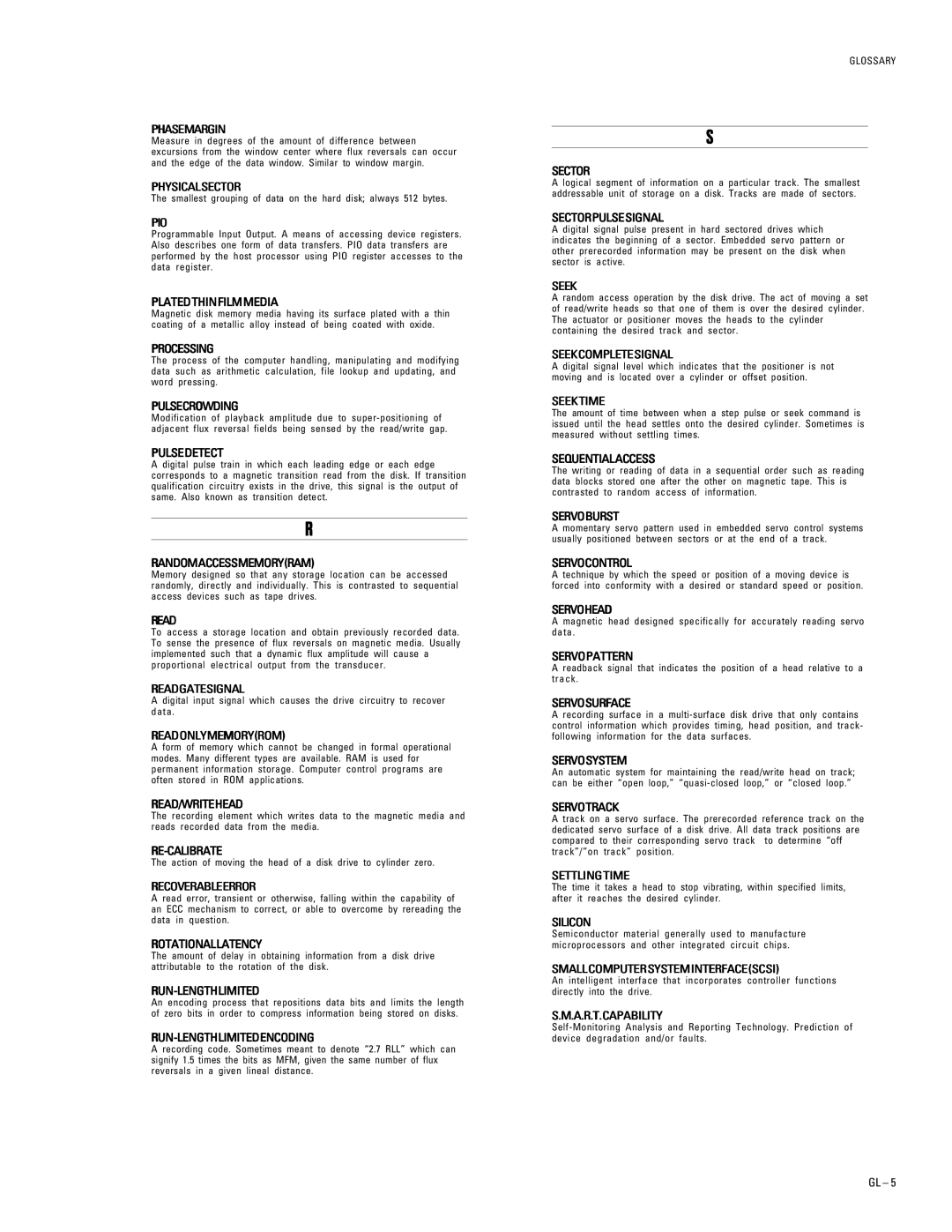PHASEMARGIN
Measure in degrees of the amount of difference between excursions from the window center where flux reversals can occur and the edge of the data window. Similar to window margin.
PHYSICALSECTOR
The smallest grouping of data on the hard disk; always 512 bytes.
PIO
Programmable Input Output. A means of accessing device registers. Also describes one form of data transfers. PIO data transfers are performed by the host processor using PIO register accesses to the data register.
PLATEDTHINFILMMEDIA
Magnetic disk memory media having its surface plated with a thin coating of a metallic alloy instead of being coated with oxide.
PROCESSING
The process of the computer handling, manipulating and modifying data such as arithmetic calculation, file lookup and updating, and word pressing.
PULSECROWDING
Modification of playback amplitude due to super-positioning of adjacent flux reversal fields being sensed by the read/write gap.
PULSEDETECT
A digital pulse train in which each leading edge or each edge corresponds to a magnetic transition read from the disk. If transition qualification circuitry exists in the drive, this signal is the output of same. Also known as transition detect.
R
RANDOMACCESSMEMORY(RAM)
Memory designed so that any storage location can be accessed randomly, directly and individually. This is contrasted to sequential access devices such as tape drives.
READ
To access a storage location and obtain previously recorded data. To sense the presence of flux reversals on magnetic media. Usually implemented such that a dynamic flux amplitude will cause a proportional electrical output from the transducer.
READGATESIGNAL
A digital input signal which causes the drive circuitry to recover data.
READONLYMEMORY(ROM)
A form of memory which cannot be changed in formal operational modes. Many different types are available. RAM is used for permanent information storage. Computer control programs are often stored in ROM applications.
READ/WRITEHEAD
The recording element which writes data to the magnetic media and reads recorded data from the media.
RE-CALIBRATE
The action of moving the head of a disk drive to cylinder zero.
RECOVERABLEERROR
A read error, transient or otherwise, falling within the capability of an ECC mechanism to correct, or able to overcome by rereading the data in question.
ROTATIONALLATENCY
The amount of delay in obtaining information from a disk drive attributable to the rotation of the disk.
RUN-LENGTHLIMITED
An encoding process that repositions data bits and limits the length of zero bits in order to compress information being stored on disks.
RUN-LENGTHLIMITEDENCODING
A recording code. Sometimes meant to denote “2.7 RLL” which can signify 1.5 times the bits as MFM, given the same number of flux reversals in a given lineal distance.
GLOSSARY
S
SECTOR
A logical segment of information on a particular track. The smallest addressable unit of storage on a disk. Tracks are made of sectors.
SECTORPULSESIGNAL
A digital signal pulse present in hard sectored drives which indicates the beginning of a sector. Embedded servo pattern or other prerecorded information may be present on the disk when sector is active.
SEEK
A random access operation by the disk drive. The act of moving a set of read/write heads so that one of them is over the desired cylinder. The actuator or positioner moves the heads to the cylinder containing the desired track and sector.
SEEKCOMPLETESIGNAL
A digital signal level which indicates that the positioner is not moving and is located over a cylinder or offset position.
SEEKTIME
The amount of time between when a step pulse or seek command is issued until the head settles onto the desired cylinder. Sometimes is measured without settling times.
SEQUENTIALACCESS
The writing or reading of data in a sequential order such as reading data blocks stored one after the other on magnetic tape. This is contrasted to random access of information.
SERVOBURST
A momentary servo pattern used in embedded servo control systems usually positioned between sectors or at the end of a track.
SERVOCONTROL
A technique by which the speed or position of a moving device is forced into conformity with a desired or standard speed or position.
SERVOHEAD
A magnetic head designed specifically for accurately reading servo data.
SERVOPATTERN
A readback signal that indicates the position of a head relative to a track.
SERVOSURFACE
A recording surface in a multi-surface disk drive that only contains control information which provides timing, head position, and track- following information for the data surfaces.
SERVOSYSTEM
An automatic system for maintaining the read/write head on track; can be either “open loop,” “quasi-closed loop,” or “closed loop.”
SERVOTRACK
A track on a servo surface. The prerecorded reference track on the dedicated servo surface of a disk drive. All data track positions are compared to their corresponding servo track to determine “off track”/”on track” position.
SETTLINGTIME
The time it takes a head to stop vibrating, within specified limits, after it reaches the desired cylinder.
SILICON
Semiconductor material generally used to manufacture microprocessors and other integrated circuit chips.
SMALLCOMPUTERSYSTEMINTERFACE(SCSI)
An intelligent interface that incorporates controller functions directly into the drive.
S.M.A.R.T.CAPABILITY
Self-Monitoring Analysis and Reporting Technology. Prediction of device degradation and/or faults.

